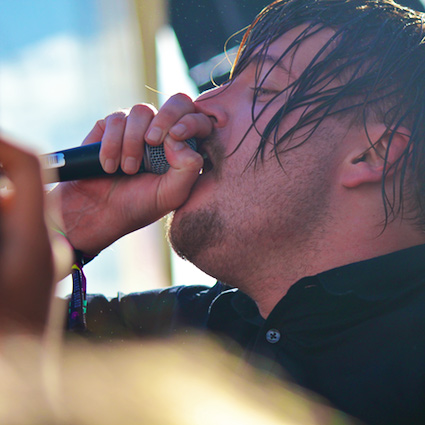
PHOTOS: REEVES PEELER | In its tenth and final year on Treasure Island, the Treasure Island Music Festival redefined my understanding of “agoraphobia.” Weather, location, communication and transportation were all stacked against Treasure Island, and I wasn’t the only Sunday festival-goer looking for a marginally convincing reason to stay in my pajamas. Yet somehow, on Sunday night I boarded a packed tour bus—cold, wet and dirty—with a big smile that reflected confidence in my decision to have made the trek.
This year, the festival had to move from one end of the island to the other, eliminating the insane city view that so many festival-goers hope to Instagram (a new location that festival organizers spun as offering “picturesque views of Oakland”). Rain and high winds set the tone for the entire weekend, forcing major festival draws like How to Dress Well and Ice Cube to play much-abbreviated sets, and bands on both days, including Flight Facilities and James Blake, to cancel their sets altogether.

Weekend ticket holders took to social media in droves demanding refunds after Saturday’s weather-induced fiasco (which apparently included a vending machine injury). But Sunday was a slight redemption for Treasure Island, as the crowd adjusted its expectations, adapted to the environment, and hunkered down on a mission to enjoy day two.
Car Seat Headrest was the start to my Sunday on Treasure Island. Admittedly not an objective review, this was my fourth Car Seat show since they played The Independent in January 2016. Each time I’ve seen Will Toledo and his band play, I catch something new that keeps me coming back for the next show. It’s the type of set that forces you to focus on one band member at a time, exposing something real about each musician in the context of a stunningly cohesive set.
They’ve put out an impressive 12 albums since 2011, the first ten of which were self-released. Signing to Matador for their most recent Teens of Style and Teens of Denial, Car Seat Headrest’s meteoric ascent has seemed somewhat inevitable. Since this time last year, the Seattle-based DIY band has graced the lineups of major music festivals, but felt at home on Treasure Island among homemade pirate props and soaking wet Patagonias. Their crowd, albeit sleepy to start, seemed ready to participate in Car Seat’s relatable angst. It was a solid start to Sunday.



Christine and The Queens was an interesting backdrop to a set change between Car Seat Headrest and Deafheaven, taking the crowd from one extreme to the next. Their brand of bubbly, feel-good electropop stood in stark contrast with the set Deafheaven was about to unleash on unsuspecting festival goers. The Deafheaven pre-crowd was buzzing with commentary, aptly noting that “it sounds like she’s talking to a room full of kindergarteners.” This was an accurate assessment.
As Deafheaven took the stage at 3:30, it was immediately clear this wasn’t a typical homecoming show. Against a lineup heavy with dance music, trop-pop, R&B, and ambient electronica, Deafheaven and their stage-side posse were ready to set themselves apart.










Easily the loudest, darkest set of the weekend, Deafheaven showed Treasure Island what an emotional rollercoaster should sound like. Wavering between low-tempo shoegaze and heavy hitting black metal, this show brought more sonic diversity to the festival than anyone anticipated. Coupled with impossibly schizophrenic weather (one minute it was cold and rainy, and the next a rainbow emerged from black storm clouds), this was one of the most entertaining and memorable festival shows I’ve ever seen. But given the dichotomy between acts and the blatant acknowledgement by Deafheaven front man, George Clark, that they were “clearly the odd man out,” it made sense that the crowd gave mixed reviews.
Following Deafheaven, I decided to get close for Neon Indian—a band that helped define my 2010—in part so I could try to understand how they’re still drawing hype.



Full of flashy dance moves and catchy beats, the 40-minute set portrayed the carefully stylized persona of front man, Alan Palomo. And for reasons I can’t articulate, the performance felt completely forced and exhausted. Among vapid lyrics, one-track dance moves and a watery ’80s sound, this entire set could have been edited into a 30-second soda commercial.
I walked away with a newfound appreciation for the old Neon Indian, and an understanding that what remains is more aesthetics than music.
To redeem my love of dance music, Sylvan Esso over-delivered in what was easily my favorite show of the festival. It was the perfect act to transition from day to night, creating a positivity and sense of community that made the sheets of rain and cold evening air feel good. There wasn’t a still body in the crowd as the duo closed out their 11-show 2016 tour by introducing brand new songs in a perfectly sequenced set list. The crowd huddled close, embraced each other’s body heat, and forgot they were trapped on an island waist-deep in beer mud.





Treasure Island is a perennial closeout to San Francisco’s Indian Summer. It’s one of the last stops on the festival circuit, so it tends to draw a handful of weary acts responsible for selling out big budget productions like Outside Lands, Coachella, ACL, Lollapalooza, etc. What Treasure Island organizers—Another Planet and Noise Pop—do well, however, is keep the lineup fresh and the vibe DIY. And this year we got the predictable pop, electronic, and R&B everyone expected, with plot twists like Ice Cube and Deafheaven that helped diversify the audience.
It’s the last year Treasure Island will be held on Treasure Island. And once the PR storm blows over, perhaps the weather and logistical failures of 2016 will serve as reassurance that a move is for the best.





